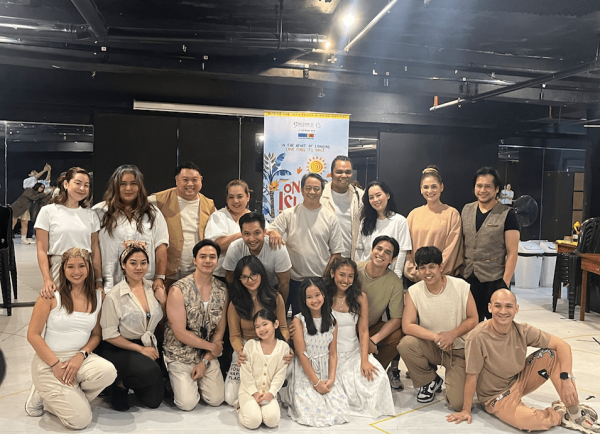
‘Once on This Island’ Promises Contemporary Charm and Cultural Resonance
9 Works Theatrical is set to stage the Broadway musical Once on This Island this September at the Carlos P. Romulo Auditorium of RCBC Plaza. What can audiences expect from this staging?
Debuting on Broadway in 1990, Director Robbie Guevara says they will present this musical classic in a contemporary way that appeals to modern audiences.
Set in the 1920s to early 1930s on a tropical island in the French Antilles, Once on This Island depicts two distinct social classes: the wealthy grands hommes, lighter-skinned descendants of French colonizers, and the peasants, darker-skinned descendants of African slaves. “[Two] of the main issues were race and class, which are still prevalent today, and it needs to be highlighted and learned from,” says Guevara. “It’s part of that continuous education of not being bigots based on color and based on class. This is a very endearing way of showing humanity, family, and community.”
The creative team decided to expand the cast from the original 11 to 15 per show, 21 including all the alternates, to highlight the dancing. Mio Infante teases that the production design will look like a dance set with a lot of movement, thanks to choreographer JM Cabling. Apart from casting based on their singing and dancing ability, Guevara says they also ensured diversity in appearances. “You have a village representing a nation, so we really want to showcase as much as we can. Even the kids, they’re not the same size.”

the cast of Once on This Island; Photo Credit: Frida Tan
FRENCH ANTILLES SILHOUETTES
In terms of costume design, Infante says that it will feel quite Filipino. “We’ll choose silhouettes that would make it a little more Martinique, more French Antilles. They followed the European dress and adapted it to the tropical weather, which is what we did. We’re looking at that and then underlining several things that will set it apart so that the market here wouldn’t see that it’s too Filipino.”
“Another interesting thing in the research was that in the French Antilles, they had the African heritage from the slaves who worked in the sugarcane fields,” he adds. “So they infused African tradition, even African voodoo, and all these pagan rituals with Catholicism and Christianity. It’s very similar because it’s an island, a colony, in the early 20th century.”
The story begins with villagers comforting a young girl during a storm by telling her the story of Ti Moune, a peasant girl who falls in love with a wealthy boy named Daniel Beauxhomme. The opening song “We Dance” immediately immerses audiences in a world with a deep colonial past, a social class divide, and a strong belief in the gods.
SUPERSTITIONS AND COLONIAL PAST
Infante shares that the story’s belief systems are similar to Filipino folk and oral traditions, where indigenous beliefs were infused before and after colonization. He notes that just as Filipinos have mythological characters like the aswang and tikbalang, the people in the French Antilles have African heritage beliefs such as voodoo. “Papa Ge looks like a voodoo, but Shiela and Jasmine’s character [Erzulie] looks like Mama Mary. So it’s that tradition na nag-iiba eh, but it’s infused with so many things,” he explains. “Even the healing portion, it’s the folkness of healing with herbs, and the like. It’s very similar with our folk traditions.”
“In the Philippines, we have our pamahiin, it’s the same with them,” adds Shiela Valderrama-Martinez. “They have their superstition. They have the names of their different gods and goddesses. It’s the same for the Filipinos, and any other culture especially the indigenous ones. It’s similar that way because we’re also an island. We were colonized, we have oppression, we have color disparity. It’s similar that way and I think we as Filipinos can really relate to it because we see it even until now.”
“When they do exercise the voodoo, it’s with sincerity and with belief that there’s healing involved. That’s the only truthful way of depicting it,” says Guevara. “There’s no statement to mock it, there’s no statement to make it look ridiculous. It’s really sincere.”
THE TI MOUNE’S
Leading the cast are Angela Ken and Thea Astley, who alternate as Ti Moune. Ken shares that she wasn’t really familiar with the musical before auditions but quickly grew to love it. “Noong inaaral ko siya when I came to the auditions, grabe iyung kaba. Iyung hunger to get the role is there kasi the story of Ti Moune is actually relevant sa generation natin ngayon. Nakaka-touch siya ng puso and at the same time, marami kang matututunan as a teenager, as a Gen Z, or kahit na anong edad ka pa.”
Astley, on the other hand, fell madly in love with the musical after seeing the Broadway revival in 2017. She shares that when she came back to the Philippines and entered her first year in Ateneo, she joined Ateneo blueREP and chose Waiting for Life as her audition song. “This is really a dream role of mine. It feels like a big full circle moment for me to be doing this musical now. Kaya nga when [Executive Producer] Mr. Santi [Santamaria] approached me to sing Waiting for Life at the closing show of Rent to announce Once on This Island, I told him, I already know this song. (laughs) I know this song inside and out.”
View this post on Instagram
“And I can never fully claim to know the experience of Ti Moune, of the peasants, of black people, pero I know what it’s like to be looked down upon because you’re darker,” she shares. “Ngayon kasi medyo nag-progress na tayo in terms of what we think beauty is, pero before, kahit ‘nung when I was in elementary, lagi bago ako pumasok, gigising ako nang super maaga para magplantsa ng buhok kasi dati sa commercial, ang maganda ay maputi, straight, black hair. Eh paano [ako], morena tapos kinky iyung hair? Ayaw ko pumasok ng ganun, nabu-bully ako. So that’s how I relate to Ti Moune and I think a lot of young boys and girls alike will relate to it in that way as well.”
Joining them in the cast are Sam Concepcion and Jef Flores as Daniel, Garrett Bolden as Agwe, Radha as Asaka, Lorenz Martinez as Papa Ge, Shiela Valderrama-Martinez and Jasmine Fitzgerald as Erzulie, Raul Montesa and Noel Rayos as Tonton Julian, Lani Ligot as Mama Euralie, Shanaia Gomez and Krystal Kane as Andrea, PJ Rebullida as Armand, Jonjon Martin, Sam Libao, Jordan Andrews, and Fay Castro as the Storytellers, and Bianca Estacio and Reese Iso as Little Ti Moune.
The creative team includes Daniel Bartolome (musical director) and Lionel Guico (vocal coach), alongside Guevara, Infante, and Cabling.
The show will run from September 6 to 29 at the Carlos P. Romulo Auditorium of RCBC Plaza. Tickets are available through Ticket2Me. You can watch the cast perform a sneak peek of We Dance in the video below.


Comments